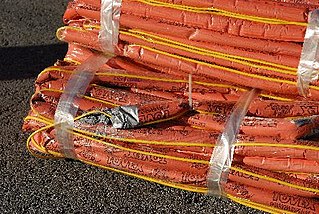Related Research Articles

RDX is an organic compound with the formula (O2N2CH2)3. It is a white solid without smell or taste, widely used as an explosive. Chemically, it is classified as a nitramide alongside HMX, which is a more energetic explosive than TNT. It was used widely in World War II and remains common in military applications.

Dynamite is an explosive made of nitroglycerin, sorbents and stabilizers. It was invented by the Swedish chemist and engineer Alfred Nobel in Geesthacht, Northern Germany and patented in 1867. It rapidly gained wide-scale use as a more powerful alternative to black powder.

An explosive is a reactive substance that contains a great amount of potential energy that can produce an explosion if released suddenly, usually accompanied by the production of light, heat, sound, and pressure. An explosive charge is a measured quantity of explosive material, which may either be composed solely of one ingredient or be a mixture containing at least two substances.

Nitroglycerin (NG), also known as nitroglycerine, trinitroglycerin (TNG), nitro, glyceryl trinitrate (GTN), or 1,2,3-trinitroxypropane, is a dense, colorless, oily, explosive liquid most commonly produced by nitrating glycerol with white fuming nitric acid under conditions appropriate to the formation of the nitric acid ester. Chemically, the substance is an organic nitrate compound rather than a nitro compound, but the traditional name is retained. Invented in 1847 by Ascanio Sobrero, nitroglycerin has been used ever since as an active ingredient in the manufacture of explosives, namely dynamite, and as such it is employed in the construction, demolition, and mining industries. Since the 1880s, it has been used by the military as an active ingredient and gelatinizer for nitrocellulose in some solid propellants such as cordite and ballistite. It is a major component in double-based smokeless gunpowders used by reloaders. Combined with nitrocellulose, hundreds of powder combinations are used by rifle, pistol, and shotgun reloaders.

Trinitrotoluene (; TNT), or more specifically 2,4,6-trinitrotoluene, is a chemical compound with the formula C6H2(NO2)3CH3. This yellow solid is occasionally used as a reagent in chemical synthesis, but it is best known as an explosive material with convenient handling properties. The explosive yield of TNT is considered to be the standard comparative convention of bombs and the destructiveness of explosives. In chemistry, TNT is used to generate charge transfer salts.

Pentaerythritol tetranitrate (PETN), also known as PENT, PENTA, TEN, corpent, or penthrite, is an explosive material. It is the nitrate ester of pentaerythritol, and is structurally very similar to nitroglycerin. Penta refers to the five carbon atoms of the neopentane skeleton. PETN is a powerful explosive material with a relative effectiveness factor of 1.66. When mixed with a plasticizer, PETN forms a plastic explosive. Along with RDX it is the main ingredient of Semtex.

Ammonium nitrate is a chemical compound with the chemical formula NH4NO3. It is a white crystalline solid consisting of ions of ammonium and nitrate. It is highly soluble in water and hygroscopic as a solid, although it does not form hydrates. It is predominantly used in agriculture as a high-nitrogen fertilizer. Global production was estimated at 21.6 million tonnes in 2017.

C-4 or Composition C-4 is a common variety of the plastic explosive family known as Composition C, which uses RDX as its explosive agent. C-4 is composed of explosives, plastic binder, plasticizer to make it malleable, and usually a marker or odorizing taggant chemical. C-4 has a texture similar to modelling clay and can be molded into any desired shape. C-4 is metastable and can be exploded only by the shock wave from a detonator or blasting cap.

ANFO is a widely used bulk industrial explosive. Its name is commonly pronounced as "ANN-foe".
A polymer-bonded explosive, also called PBX or plastic-bonded explosive, is an explosive material in which explosive powder is bound together in a matrix using small quantities of a synthetic polymer. PBXs are normally used for explosive materials that are not easily melted into a casting, or are otherwise difficult to form. PBX was first developed in 1952 at Los Alamos National Laboratory, as RDX embedded in polystyrene with dioctyl phthalate plasticizer. HMX compositions with teflon-based binders were developed in 1960s and 1970s for gun shells and for Apollo Lunar Surface Experiments Package (ALSEP) seismic experiments, although the latter experiments are usually cited as using hexanitrostilbene (HNS).

Amatol is a highly explosive material made from a mixture of TNT and ammonium nitrate. The British name originates from the words ammonium and toluene. Similar mixtures were known as Schneiderite in France. Amatol was used extensively during World War I and World War II, typically as an explosive in military weapons such as aircraft bombs, shells, depth charges, and naval mines. It was eventually replaced with alternative explosives such as Composition B, Torpex, and tritonal.
A triggering sequence, also called an explosive train, is a sequence of events that culminates in the detonation of explosives. For safety reasons, most widely used high explosives are difficult to detonate. A primary explosive of higher sensitivity is used to trigger a uniform and predictable detonation of the main body of the explosive. Although the primary explosive itself is generally a more sensitive and expensive compound, it is only used in small quantities and in relatively safely packaged forms. By design there are low explosives and high explosives made such that the low explosives are highly sensitive and high explosives are comparatively insensitive. This not only affords inherent safety to the usage of explosives during handling and transport, but also necessitates an explosive triggering sequence or explosive train. The explosive triggering sequence or the explosive train essentially consists of an 'initiator', an 'intermediary' and the 'high explosive'.

Mannitol hexanitrate is a powerful explosive. Physically, it is a powdery solid at normal temperature ranges, with density of 1.73 g/cm3. The chemical name is hexanitromannitol and it is also known as nitromannite, MHN, and nitromannitol, and by the trademarks Nitranitol and Mannitrin. It is more stable than nitroglycerin, and it is used in detonators.
Shock sensitivity is a comparative measure of the sensitivity to sudden compression of an explosive chemical compound. Determination of the shock sensitivity of a material intended for practical use is one important aspect of safety testing of explosives. A variety of tests and indices are in use, of which one of the more common is the Rotter Impact Test with results expressed as FoI At least four other impact tests are in common use, while various "gap tests" are used to measure sensitivity to blast shock.

A phlegmatizedexplosive is an explosive that has had an agent added to stabilize or desensitize it. Sometimes this is desirable either to improve the handling properties of an explosive or to reduce its sensitivity, brisance or detonation velocity. TNT explosive can itself be used to phlegmatize more sensitive explosives such as RDX, HMX or PETN. Other typical phlegmatizing agents include paraffin wax, paper or even water. Such agents are nearly always flammable themselves or will at least boil off easily. Typically, a small amount of phlegmatizing agent is used e.g. Composition B, which has 1% paraffin wax added, or the Russian RGO hand grenade which contains 90 grams of "A-IX-1" explosive, comprising 96% RDX and 4% paraffin wax by weight. Another example of use is the VS-50 antipersonnel mine, which contains an explosive filling of 43 grams of RDX, again phlegmatized by combining it with 10% paraffin wax by weight.

TATB, triaminotrinitrobenzene or 2,4,6-triamino-1,3,5- trinitrobenzene is an aromatic explosive, based on the basic six-carbon benzene ring structure with three nitro functional groups (NO2) and three amine (NH2) groups attached, alternating around the ring.
Astrolite is the trade name of a family of explosives, invented by chemist Gerald Hurst in the 1960s during his employment with the Atlas Powder Company. The Astrolite family consists of two compounds, Astrolite G and Astrolite A. Both are two-part liquid-state high explosive mixtures, composed of ammonium nitrate oxidizer and hydrazine rocket fuel. The explosives were extensively studied, manufactured, and used in many countries because of their advantages of high energy, excellent performance, and wide application. They still find some use in commercial and civil blasting applications, but have mostly been superseded by cheaper and safer compounds, largely due to the expense and exceptionally poisonous nature of the hydrazine component.

Tovex is a water-gel explosive composed of ammonium nitrate and methylammonium nitrate that has several advantages over traditional dynamite, including lower toxicity and safer manufacture, transport, and storage. It has thus almost entirely replaced dynamite. There are numerous versions ranging from shearing charges to aluminized common blasting agents. Tovex is used by 80% of international oil companies for seismic exploration.

Methylammonium nitrate is an explosive chemical with the molecular formula CH6N2O3, alternately CH3NH3+NO3−. It is the salt formed by the neutralization of methylamine with nitric acid. This substance is also known as methylamine nitrate and monomethylamine nitrate, not to be confused with methyl nitramine or monomethyl nitramine.

A water-gel explosive is a fuel sensitized explosive mixture consisting of an aqueous ammonium nitrate solution that acts as the oxidizer. Water gels that are cap-insensitive are referred to under United States safety regulations as blasting agents. Water gel explosives have a jelly-like consistency and come in sausage-like packing stapled shut on both sides.
References
- 1 2 3 Cooper, Paul W. (1996). "Chapter 4: Use forms of explosives". Explosives Engineering . Wiley-VCH. pp. 51–66. ISBN 0-471-18636-8.
- ↑ Astrolite usenet posts archived at Yarchive, accessed 2008-12-28